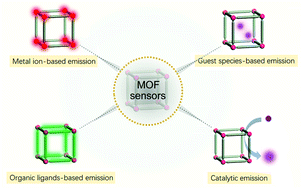Metal–organic frameworks (MOFs), with diverse framework architectures, have evolved as next-generation utility multifunctional hybrid materials. One of the key features of MOFs is their luminescence properties, which can be generated from the building ligands, emissive metal ions, guest ions, or molecules used to construct them as well as from their catalytic activities. MOFs with luminescent properties have been used as excellent platforms for designing luminescent sensors. Their chemically tailorable framework with specific host–guest interactions plays an important role in selectively sensing metal ions, small organic molecules, and biomolecules. This review intends to summarize the recent advances in the construction of MOF-based sensors for chemical sensing and biosensing. Specially, we focus on the fabrication strategies of MOF-based luminescent sensors, and summarize their sensing mechanisms in detail. Also, the major challenges and constraints for this research field are discussed.
